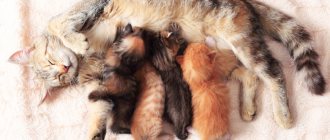What's wrong with the cat? Why doesn't the cat feed the kittens?
Cats are endowed with a strong maternal instinct and from the first minutes of life they carefully take care of each of their babies. But it also happens that females abandon and abandon their offspring. Why is this happening? What's wrong with the cat and what to do if the female doesn't have milk?
Reasons why cats may abandon kittens:
- Health problems, difficult childbirth, postpartum complications (mastitis, eclampsia, endometritis, pyometra). For example, with eclampsia (milk fever), cats' behavior changes dramatically. Females refuse their cubs, may show aggression towards them, or even eat their own litter. With mastitis, due to inflammation of the milk bags, milk secretion is disrupted. The cat does not allow her to touch her nipples or belly, and cannot feed the kittens.
- Too early pregnancy and childbirth. Unsterilized outdoor cats can become pregnant during their first heat, before reaching full sexual maturity.
- Non-viable offspring. Cats abandon weak, sick kittens.
- Hormonal disorders caused by stress, improper care of the cat during pregnancy, health problems, disruptions in the endocrine system, and others, drugs that suppress the rut (“Anti-sex”).
- Lack of lactation. Colostrum appears in cats about an hour after the kittens are born.
- First birth. Despite the fact that cats have a highly developed maternal instinct, due to inexperience, especially if the female gives birth for the first time, she abandons the babies, not knowing what to do with them.
- Poor care during pregnancy, stress.
Why did the cat stop going to the litter box and what should I do?
How often, with such a problem as “the cat has stopped going to the litter box,” the owners say that the cat is taking revenge, doing it out of spite, and some claim that the animal has gone crazy...
Of course, the possibility of a pet becoming angry with one of the family members, stress or circumstances in general cannot be ruled out, but quite often the problem lies elsewhere, you just need to be more attentive to your pet.
Reasons why a cat refuses to go to the toilet and solutions
Infections (cystitis in cats) or injuries can cause excessive urination and the animal simply does not have time to reach the intended place. If there are stones in the genitourinary tract, then urine excretion becomes impossible due to compression of the ducts.
Carefully inspect the tray, the places where your animal is, and be sure to go for a consultation with a veterinarian! Do not rush to resort to various attractive sprays, and even more so, do not even think about scolding the animal until the reasons are clarified.
Cats are very clean animals, see if the tray is clean enough, wash it thoroughly, whether the filler is clean, or maybe the scoop with which you poured the filler is dirty and leaves a smell that a person cannot smell, but it is unacceptable for a cat.
Maybe you like everything about the new tray (it’s shiny, big, beautiful and matches the color of the tiles/wallpaper), but for some reason it doesn’t suit the cat and that’s all.
And despite the fact that the new tray is so beautiful, he wouldn’t set foot in it, but he would gladly go into the old one, scratched and not shiny. Therefore, do not rush to throw away the old tray when buying a new one.
I personally encountered this problem. The fact is that from birth my cat went to pressed wood filler, when I brought her to my house, she flatly refused to go to the already,
Don Sphynx Rat
Rules for feeding kittens without a mother
If a cat refuses to feed her babies, has health problems, postpartum complications, or, unfortunately, the pet died during childbirth, owners should know the rules for feeding kittens without a mother.
If the kittens are orphaned, try to find another nursing cat in the next few hours. This is the best option, because kittens receive useful substances and protective antibodies with milk and colostrum.
To get another cat to accept someone else's children, take a “donor” kitten and wipe the foundling on it.
If you are unable to find another nursing cat, you need to act correctly and immediately. There are many nuances regarding feeding and care that will save the lives of kittens. It is important not only to provide regular nutrition to children, but also to create safe, favorable living conditions.
Examine each kitten. The babies are not yet standing on their paws, but if the kittens are not sleeping, they are constantly moving (crawling). Healthy kittens have warm skin, a rounded tummy, and a well-defined sucking reflex. If the kitten is lethargic and cold, this is an alarming signal . Perhaps the baby has health problems or is not viable. In non-viable kittens, the sucking reflex is weak or completely absent.
Important! Inspect and monitor the condition of newborn kittens daily, several times every morning, including at night.
Hungry kittens show anxiety, constantly squeak, and try to suck on a finger. In order for the babies to become stronger, grow normally, gain weight, and develop well, it is important to follow certain rules for feeding newborn kittens.
A well-fed kitten behaves calmly. His abdomen is slightly distended and he falls asleep immediately after eating. If the kitten continues to squeak, it means that he has not yet received the portion he needs to be satisfied.
Other care details
After feeding, use light, clockwise circular motions to massage the base of the kitten's tummy. Mother cats constantly lick the kittens' abdomen and genital area, thereby stimulating their digestion.
Also remember that in the first two weeks, kittens cannot pee or poop on their own. Therefore, after eating, you need to massage the tummy and lubricate the genitals with a sterile swab dipped in warm water.
To maintain the temperature necessary for life and metabolism, kittens need to be warm. Use a heating pad wrapped in a terry towel or a special lamp. If kittens are not warmed, they will die.
What should the owner do to get the cat to accept the kittens back?
First of all, contact a veterinarian and call him to your home. The specialist will make a diagnosis and recommend treatment. After this, the cat will calm down, the pain and discomfort will go away, and lactation will begin to recover. During the normal course of the birth process, the cat is provided with a dark and quiet place so that no one disturbs it and its offspring.
You should not touch the babies with ungloved hands - this can interrupt the smell that is familiar to the mother cat, and she will refuse to feed the babies. A cat that does not show the initiative to feed is affectionately seated next to the babies, petted and talked to, discreetly placing a kitten next to it. You can try to “mark” the kittens with the smell of their mother (a drop of milk or urine), sour cream or another favorite treat. So, by licking the treat, the cat will also lick the kitten.
If the above measures do not bear fruit, the babies have to be artificially fed. At the same time, we must not forget about the other functions of the mother - warming the babies, maintaining hygiene, maintaining a constant temperature in the nest (not lower than 26 degrees). The kittens' habitat is covered with a clean cloth or baby diapers that absorb moisture.
Important! The fabric to be covered must be soft and natural, not fray or stretch, and not serve as a source of static electricity.
Babies should be examined before and after feeding. If there are no alarming signs at first glance, do a light massage of the tummy and areas of the reproductive system. The massage is performed with a soft cotton sponge. The meaning of the procedure is to imitate cat licking. Without such imitation, kittens cannot empty their bladder and intestines, which is why they die. The intestines of a kitten that has not received colostrum are sterile.
If you feed kittens incorrectly, microflora develops in the intestines, contributing to digestive problems, indigestion and bloating. An artificial diet that is unsuitable for kittens can lead to the death of babies.
It is important to prepare for the birth of your pet by making, just in case, a list of necessary purchases for feeding the offspring.
This includes: a heating pad (it’s better if it’s electric). As a last resort, plastic bottles filled with heated water are used for heating; they need to be wrapped in terry cloth. You can also warm the kitten with your body by squeezing the baby close to you.
What you need for feeding
To feed your pets you need to purchase everything you need.
What you need to feed a kitten:
- Special mixtures, nutrition.
- Cat milk substitutes.
- Pipette, disposable syringes without a needle or with a rubber nozzle;
- Bottles with nipple. Use the Catac kitten feeding bottle.
- Disposable moisture-absorbing diapers, cotton pads.
- Medicines for intestinal colic for infants.
Important! There are ready-made kits on sale for feeding small kittens, which contain all the necessary tools and utensils.
Please note that whole cow's milk is not suitable for feeding a newborn kitten. The lactose contained in it is not absorbed by the gastrointestinal tract of kittens and can cause intestinal upset.
Until you purchase a cat's milk substitute or infant formula, it is better to use goat's milk for feeding.
If this option is not possible, boil low-fat cow's milk, dilute it with water by half, add one raw yolk, a little honey or sugar or 3-4 drops of glucose. For 500 ml of milk 1 egg yolk, 4 tsp. Sahara.
How and what to feed a kitten
Many of us are faced with the problem when a cat refuses her newborn babies. And we have to resort to feeding the kittens ourselves. Each of us immediately asks the question: what to feed the kitten? And how to do this correctly so as not to harm such a tiny creature?
What to feed a kitten: basic diet
To correctly create a diet for feeding kittens, you need to take into account their age. Until the first month, if the cat has stopped feeding milk, they must be fed with their own formulas of cat milk substitutes, which are sold in any pet store, or prepared independently.
It is worth remembering that kittens of such a young age should never be given cow's milk because it is very fatty and can cause stomach upset. In a month, when the kittens grow up, you can add cottage cheese and low-fat kefir to their diet. At one and a half months, kittens begin to eat on their own.
What are the best foods to feed kittens?
Firstly, since the kitten is a future predatory animal, it needs to eat meat, but only lean meat (extra fat is of no use). It is not recommended to feed raw meat; you can scald it with boiling water, or it is best to simply cook it. It is also recommended to give frozen meat.
Chicken or any poultry meat can be given, but only without bones. Otherwise, the animal may be injured; bones are contraindicated for use as food. For kittens, it is better to choose chicken fillet, and before giving it to them, it is better to grind it, so it will be more convenient for them to eat and they will not choke.
Cottage cheese is a healthy product for kittens. It contains a lot of useful microelements. It can be diluted a little with sour cream, it will be even tastier, but you shouldn’t add a lot of sour cream, it can lead to stomach upset.
Feeding methods
It is important to hold the kitten correctly during feeding.
- Don't turn it over on its back. It is not right.
- Place the baby on your lap or, best of all, use a container with low sides, which is covered with a cloth or diaper before feeding. The hind legs should rest on the bottom, and the front legs on the sides.
- Gently lift the muzzle up, lightly pulling the animal by the scruff of the neck. Over time, the fluffy will choose a comfortable position for eating.
- While feeding, pet and talk in a gentle tone to the kitten.
Important! For the first five days, kittens are fed with a pipette. If an older kitten refuses to eat from a bottle with a nipple, continue to give the mixture with a pipette or use a syringe (No. 2), pouring food drop by drop with its mouth slightly open.
Before giving food to small pets, immerse the bottle in warm water. You can feed babies only with mixtures at room temperature (35-36 degrees). Feed kittens in a warm, draft-free room.
After feeding, kittens may burp in the first two weeks of life. Place it on your chest and stroke the animal's back for a few minutes until it burps.
Feed the kitten if it is warm and its temperature is not lower than 35-36 degrees. Low body temperature slows down metabolism and can cause aspiration pneumonia.
If your cat is cold, place him near a heating pad and as soon as his body temperature rises, start feeding him. After eating, in addition to massage, wipe the kitten's face with a damp sterile cloth soaked in warm water. Rinse well and disinfect the bottles (in the oven, microwave).
Use new pipettes and syringes for each feeding, since kittens with fragile immunity are very sensitive to infections. Tools and utensils for feeding must be sterile.
Monitor your kittens' weight. Daily weight gain is 20-25 grams. At two weeks of age, kittens should weigh approximately 200-210 g depending on the breed, and at three weeks - 280-300 g.
How to care for kittens
Babies left without parental care need not only proper feeding, but also full care. A person must do everything so that the newborn pet does not feel inferior and receives the proper warmth, attention and affection. Functions of a cat that a person should take on:
- Heating. Kittens lack thermoregulation function. It is important for the baby to equip a “prototype nest”. A box is suitable for this, the bottom of which will need to be covered with a warm cloth. It is better to choose woolen materials that will remind your baby of touching his mother’s wool. Place heating pads with hot water on each side of the box.
- Hygiene. The cat carefully monitors the cleanliness of her cubs, constantly licking them. Therefore, a person should do the same - before each feeding, the kitten should be examined so that there are no inflammations or abscesses on its fur and skin. After feeding, wipe the fur with a damp, sterile cloth. Inspect the tray regularly and clean it as necessary.
- Massage. After feeding, you need to gently massage your tummy with a cotton swab. This will help improve digestion and stimulate the urination process.
The biggest challenge that a person caring for a newborn kitten faces is feeding. To feed kittens, you can use specialized formulas sold in pet stores, or prepare them yourself.
Feeding mode
In the first month, it is very important for the health of small pets to follow a routine and feeding regime. During the first week, kittens nurse from their mother cat approximately every 60-70 minutes for 24 hours.
Feeding schedule for kittens up to a month:
- For the first 14 days, feed the kittens every two hours at night and during the day. The norm is 30 ml per 100 grams of kitten weight.
- From the second to the third week - once every 2.5-3 hours. The norm is 35-40 ml per 100 grams of weight.
- Starting from the third week, kittens are fed every 3-4 hours during the day and at night - every 5-6 hours.
- From 30-36 – every 3.5-4 hours during the day and once at night. The norm is 4045 ml per 100 grams of weight.
- Accordingly, owners should feed them with the same frequency, without losing their schedule and daily routine. Stick to the regimen until the kittens begin to eat on their own.
Is it possible to make a cat start feeding its offspring?
It is important to understand as soon as possible why a female cat refuses to feed her kittens.
What to do right away - contact the veterinarian with a house call. A veterinarian can make a diagnosis and prescribe treatment, including hormonal medications, if this is the problem. The animal should stop experiencing discomfort and pain, and normal lactation should begin.
If you are confident that labor will proceed normally, but the cat still refuses to feed the kittens, this is what you need to do.
Firstly, provide her with a cozy, slightly darkened, quiet place where nothing will disturb her and the kids.
If she does not show aggression towards the kittens, but simply does not pay attention to them, then you should sit (lay) her next to them and calmly stroke her, say something to your pet in a calm voice - and at the same time put one kitten under her side...
Newborns should not be handled with bare hands, so as not to be additionally “stained” with human odor - it is better to handle them with a hand wearing a medical glove.
In order for the cat to recognize the kittens as her offspring, they can be “marked” by smearing a little mother’s milk (if it appears on the cat’s nipples) or her urine on each fur. Sometimes there are also tips to drop a little of the cat’s favorite treat on the newborn “refuser” kitten - for example, sour cream, so that she starts licking the kitten, licking the sour cream.
Milk substitutes and formulas
The gastrointestinal tract of newborn kittens is vulnerable, so we do not recommend feeding them whole milk until one month. There are special milk substitutes and mixtures for small kittens in powder and liquid. They can be purchased at veterinary pharmacies, veterinary clinics, and online stores.
Before feeding, read the information provided by the manufacturer on the packaging. The instructions contain an approximate daily dose of food for kittens of various age groups.
Pour the prepared food into a bottle and place it in boiling water. Cat milk replacers should be at least 36-38 degrees. Before feeding your pet, check the temperature of the mixture. It, as already noted, should be at room temperature.
Industrial cat milk substitutes
Industrial cat milk substitutes are an ideal option for artificial feeding. Their composition is almost similar to cat milk. Contains all the beneficial substances for the health and growth of kittens (proteins, vitamins, amino acids, minerals).
The best manufacturers and brands of cat milk substitutes:
- Babycat Milk ROYAL CANIN. Complete complementary feeding from the first days of a kitten’s life until 2 months. Contains a high amount of protein.
- Katzenmilch. For feeding from the first days of life.
- Hartz. Can be used as a supplement for pregnant cats and feeding newborn kittens.
- Gimpet Cat-Milk.
- Nutri-Vet.
- Just Born.
- Nurturall-C.
- Dolfos Dolmilk Cat
- Beaphar Kitty milk.
Cat milk replacers can also be used for the first complementary foods, after weaning, or if the female does not have enough milk (the daily dose is reduced by 2-3 times).
Infant milk formulas for kittens
Store-bought infant formula for kittens is suitable for feeding without sugar or additives. (Nutrilon, Malyutka). They are diluted with twice as much water as indicated in the instructions.
The mixture is prepared before each feeding. You can store prepared food in the refrigerator for no more than 20-24 hours. Fresh mixtures are very well absorbed by the gastrointestinal tract of kittens.
Scott's Kitten Mix
This is a multi-component composition for artificial feeding of furry pets, prepared according to a special recipe.
Compound:
- 15 ml whole milk powder;
- 50 ml cow's milk;
- 3 g dry yeast;
- one egg yolk;
- 50 g whipped egg whites;
- 1 g vegetable oil;
- 4 grams of sugar.
All ingredients are mixed until smooth in a ceramic bowl. Warm up to 37-38 degrees, put it in a bottle or syringe and feed the kitten.
Scott's kitten formula is ideal for frail newborn kittens.
Tailing mix for kittens
Tailing's mixture for kittens can easily replace an industrial cat's milk substitute.
To prepare you will need:
- Homemade milk – 25 g;
- Powdered milk – 5 g;
- 5% glucose – 4 g;
- Multivitamins for kittens – 1 g.
Mix the components with a whisk until smooth. When using powder components, make sure that they are pre-crushed. Before feeding, the kitten is warmed up to 37-38 degrees.
Prepared food cannot be stored in refrigerators for more than two days!
Is a kitten's stomach smaller than a thimble? What to feed a kitten?
Good day to everyone, everyone, everyone. What do we know about kittens? They are sweet, gentle, so funny and funny. They bring a sea of joy and love to the house. But in addition to this, we also acquire some responsibilities for raising and caring for them. Not every person is ready for this from an experience point of view. And it doesn’t matter whether your kitten is purebred or not. It should be noted that when a kitten gets to a new home, it already has a certain amount of knowledge, which includes acquired habits. Such habits may also include a certain predisposition to food. In this article we will talk about how to provide your kitten with a comfortable and healthy diet and which foods are best for kittens.
What to feed a kitten?
The first feeding, and subsequently regular three or four meals a day, are quite capable of shaping the taste preferences of even a very small kitten. Scientists have long proven the fact that cats become real gourmets from an early age. Imagine that you took a little kitten home. And you don’t have free time, for example, during working hours during the day. It's not very good. And if the kitten is less than 2 months old, then you need to spend as much time as possible with it. And he needs to devote his time not only to entertain him, but also to accustom the kitten to the litter box and feed him 4-5 times a day. Why should kittens have such a large number of meals before they are 2 months old? Because they have very small stomachs. It will be much easier for you with a three or four month old kitten. Such a pet will most likely be trained to the tray and will eat dry food for its sweet soul. Many buyers now want to purchase “younger” kittens, but they always think in advance that this will require more training from them.
Feeding kittens
When can you start feeding kittens? Supplemental feeding of small pets that are bottle-fed is necessary for their normal growth and development. The age of supplementary feeding is determined by the condition of the kitten (activity level, appetite, health status).
When to start feeding kittens
The first complementary foods can be gradually introduced into the kittens’ diet, starting at 3-4 weeks. If the kitten is active, gains weight well, reacts to external stimuli and odors, and does not have any digestive problems, you can supplement your pet’s feeding from three weeks of age.
If you notice that complementary feeding causes diarrhea or other alarming symptoms, stop feeding until the condition is completely normalized.
What to feed a kitten: a complete guide for beginners
Improper feeding affects the growth and development of the baby, leading to external defects and internal problems, and sometimes even death.
The wrong choice of ready-made food, natural nutrition that causes allergic reactions - all this also negatively affects the growing body.
It is also important not to forget about a certain feeding schedule that is different from the schedule of an adult cat. Scary? Don't be shy, we'll figure it out!
Kitten feeding regimen
First, it is important to understand WHEN to introduce complementary foods and how often to feed the kitten. You, of course, can be guided by the kitten's hungry look, but it is better not to awaken the beast in him, and 3-4 weeks after birth, begin to gradually feed the baby.
What foods can you feed a kitten?
Remember that the food you put in your kitten's bowl should never be hot or cold. It is optimal if the food is at room temperature.
It is important to remember the consistency of food - it is better if the first portions are mushy and do not contain solid pieces. At home, a blender or an ordinary grater for milking vegetables will help with this.
Meat. It can be raw, boiled, frozen and scalded. 60-80% of a kitten's daily diet comes from lean meat. What kind of meat is suitable for a kitten - see the table below;
Porridge. In their pure form, the kitten is unlikely to be interested in them, but adding meat or vegetables radically changes the matter. Mix porridge with meat in a 1:2 ratio;
Eggs. What do kittens eat from eggs? Exclusively yolk. It is useful to give a raw yolk to a kitten once a week. Pay special attention to quail eggs - they are very healthy and quail eggs can be given whole, without separating the white from the yolk;
What to feed a one-month-old kitten (up to 1 month)
How to understand that a cat will not return to newborn kittens?
If the kittens are very small (less than three weeks old) and the mother has not returned after 4 hours, then the kittens are most likely abandoned.
If the kittens are older (they move, their eyes are open), the mother may be absent even for more than 10 hours.
You will have to wait a few hours or even a whole day to see if the mother cat returns. Watch so as not to scare her away. Your presence may prevent the cat from returning to her babies.
Even if you don't see your cat for a long time, check the kittens periodically. If they cuddle together and sleep peacefully, looking pink, warm and clean, then their mother has most likely returned. You just didn't notice. Cats, especially outdoor cats, have a knack for staying out of sight whenever they want.
Tip: Sprinkle flour near the kittens' nest. If the cat returns, it will leave paw prints.
If you have been observing for several hours or more than a day and have reason to believe that the kittens' mother is no longer around, help them. Newborn kittens will require special supplies and 24-hour care to survive.
Newborn kittens are much more at risk of hypothermia than starvation. Healthy kittens can survive for a while without food as long as they are warm. In spring and summer, they can wait for their mother for a longer time. This period is much safer than the winter months.
Since a mother cat offers her newborn kittens the best chance of survival, wait and watch the litter for as long as you can.
If you must leave before the cat returns, assess whether the kittens are in immediate danger.
Here are some conditions that may threaten them:
- Unfavorable weather: snow, rain, cold or heat
- Dogs and other animals that can harm kittens
- Heavy pedestrian or vehicular traffic
- Adults and children who can harm kittens
Try to move the kittens to a different location, but as close to their original nest as possible so that the cat can find them.
Only adopt kittens if they are in serious danger.
It is impossible to describe all possible situations. Use common sense when assessing risks.
The cat is constantly hiding kittens
Many cats that have recently given birth behave very restlessly and constantly move their kittens from place to place. Owners become confused because they do not understand how to stop this process. A cat can carry kittens even if the nest was prepared in advance and the birth went well.
Dragging is explained by only one factor - the cat does not feel safe . If you are confident that you have provided maximum comfort for the young mother and her offspring, it is wiser to isolate the family in a separate room.
Note! Cats after their first birth are more prone to constantly dragging kittens around. Restless behavior is explained by hormonal changes in the body.
If you notice that your cat is constantly carrying kittens, this process needs to be monitored. Restless behavior is not a reason to endanger children. It happens that after the next move of the offspring, the cat forgets to move one of the kittens and it freezes. Also, against the background of increased anxiety, it is important to ensure that the cat does not have access to the street.
Moving kittens once after birth is a normal occurrence due to the desire to protect the offspring. After birth, traces of amniotic fluid and secretions remain on the litter, the smell of which can attract other animals. If this happens in the wild, the kittens will most likely die.
What to do if there is no cat near newborn kittens?
If the kittens are clean and sleeping in a huddle, everything is probably fine. The cat constantly remains with her litter in the first 1-2 days after giving birth, but sometimes there is a need to leave.
Observe quietly from a safe distance or shelter - no closer than 10 meters. If you stand too close, mom won't come near them. You may have to leave completely before your cat returns to kittens. It may take a long time before she returns - until she stops feeling the presence of people near her litter.
Cats have an instinct that helps them know how long they can leave their kittens alone. She may return only in a few hours.
How to help a street cat with newborn kittens?
Even if the cat has returned to kittens, you can help the cat family:
Nutrition
By regularly providing your cat with food and water, you will eliminate the need for her to look for food. This way she will be able to devote more time to the kittens. Good nutrition will also affect the quality of milk, from which kittens receive the necessary substances.
Shelter
Cats love to raise their kittens in nests where they feel hidden and protected. Provide your cat with a place to hide. You can buy it or build it yourself. Additional insulation may also be needed.
Keep food and shelter spaced apart. The cat will find food but will not use the shelter if food is nearby because it will not want to attract other cats to food located near its shelter.
Protection
Try to keep an eye on the mother and kittens, protecting them from attacks by dogs, other cats or people.
If the cat stays in a place you know, you can help the kittens when they are a little older.










